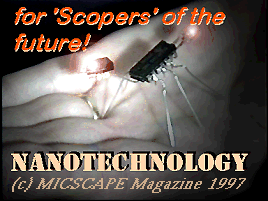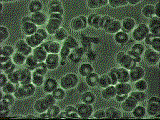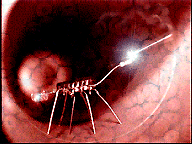

Micscape Magazine® presents something...
![]()
Artwork, text, and composition by
Maurice Smith.
Images by Andrew Syred and Maurice Smith.
© www.microscopy-uk.net 1997
![]()
Microscopists of the past were delighted to use their technology to explore the constructions of nature. Much still remains to be done by exploring the natural world with optical instruments and an enquiring mind; but whereas our ancestors could only roam the natural world, the young 'scopers' of today will have an even wider selection of subjects to study and marvel at ... NANO-BOTS: minute machines created by humankind.
Science Fiction..? Not at all. Read on!
As you read this, technologists around the world are competing to develop motors, energy systems, and mechanical devices like cogs, gears, and switches, to construct microscopic machines and new products for the future. They share a vision that tiny and selectively 'intelligent' machines can be produced to serve a diverse range of functions to benefit our civilisation. As ethically challenging as recent events in the news about genetic cloning, Nanotechnology is a revolution now emerging from the most visionary minds into our real world. What is it all about? What benefits and danger does it hold for the immediate future?
The way to begin to understand the concept behind Nanotechnology is to appreciate that when we construct things like sheets of metal, we are really processing great clumps of molecules into a desired form and shape, but if we can manipulate large blocks of molecules, what would be possible if we were instead able to manipulate single molecules or even individual atoms? In 1992 Dr. K. Eric. Drexler, postulated that many of the worlds problems could be solved by building tiny molecule-sized machines called 'assemblers' which could be programmed to produce other more sophisticated machines called nano-machines or 'Nanobots'.
Dr. Drexler had been thinking about the idea for nearly 20 years - wondering if it was possible to manufacture things the way nature does: 'bottom-up'. If human cells could reproduce according to a genetic programme, why could molecules not be programmed to do the same. Maybe Dr. Drexler's early ideas would have remained purely academic if not for the fact that within a few years of him developing the concepts, IBM invented the Scanning Tunnel Microscope! This incredible microscope works by pushing individual atoms around, and within a few years of its creation had been refined enough for IBM to use it to arrange 35 atoms of xenon to form their logo. Where up to this point, scientists had only dreamed of the possibility, this demonstration - albeit a long way from the sophisticated manipulation required to build assemblers - took academic thought into the realms of feasibility.
 In the
human body, nature has made its own organically-constructed
machines to assist in our survival - for example, white blood
cells move freely around in our blood systems selectively
locating and destroying invading counter-productive life forms
and toxins - like the one shown in this image sourced from an
optical microscope.
In the
human body, nature has made its own organically-constructed
machines to assist in our survival - for example, white blood
cells move freely around in our blood systems selectively
locating and destroying invading counter-productive life forms
and toxins - like the one shown in this image sourced from an
optical microscope.
In recent years, we have used a variety of Natural agents to assist their work - antibiotics - only to discover the 'enemy' is able to adapt and avoid their 'cleansing' function. Advocates of Nanotechnology argue that it could be feasible to construct tiny machines, with limited intelligence, small enough to inject into the human system, to provide further assistance in our continual battle for survival. It is understood that such advances would require almost unimaginable leaps in our technology, but the past has proven that once sufficient human imagination has been applied - 'effort' follows... and results are achieved!
 Who
knows, maybe the days are not so far off when tiny machines will
be working away inside your arteries, cutting away the hardened
fat with miniature lasers, and programmed to avoid attacking the
red and white blood cells already carrying out useful work.
Who
knows, maybe the days are not so far off when tiny machines will
be working away inside your arteries, cutting away the hardened
fat with miniature lasers, and programmed to avoid attacking the
red and white blood cells already carrying out useful work.
And when that happens (rather than 'if'), a whole new generation of Amateur Microscopists will be there - exploring, observing, and recording, every minute detail of these man-made constructions the way they do today for those created by Nature.
Find out more from www.nanothinc.com - a web site visited by us and considered an ideal place to begin exploring the concepts of Nanotechnology.
Please comment to: MOL
Please report any Web problems
or offer general comments to the Micscape Editor,
via the contact on current Micscape Index.
Micscape is the on-line monthly
magazine of the Microscopy UK web
site at Microscopy-UK